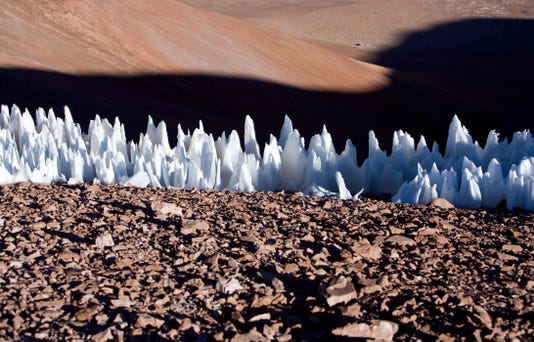


Terrestrial penitentes from the southern end of the Chajnantor plain, Chile, in 2005
The view is broadly northwards; blades can be seen perpendicular to the viewing direction. Image credit: ESO.




Terrestrial penitentes from the southern end of the Chajnantor plain, Chile, in 2005
The view is broadly northwards; blades can be seen perpendicular to the viewing direction. Image credit: ESO.



Terraformers will be calling for the elimination of ice!

It is also the sixth-largest moon in the Solar System.
Europa was discovered in 1610 by Galileo Galilei[1] and was named after Europa, the legendary mother of King Minos of Crete and lover of Zeus (the Greek equivalent of the Roman god Jupiter).
Slightly smaller than Earth’s Moon, Europa is primarily made of silicate rock and has a water-ice crust[11] and probably an iron–nickel core. It has a very thin atmosphere composed primarily of oxygen.
Its surface is striated by cracks and streaks, whereas craters are relatively rare. In addition to Earth-bound telescope observations, Europa has been examined by a succession of space probe flybys, the first occurring in the early 1970s.
Europa has the smoothest surface of any known solid object in the Solar System.[12]
The apparent youth and smoothness of the surface have led to the hypothesis that a water ocean exists beneath it, which could conceivably harbour extraterrestrial life.[13]
The predominant model suggests that heat from tidal flexing causes the ocean to remain liquid and drives ice movement similar to plate tectonics, absorbing chemicals from the surface into the ocean below.[14][15]
Sea salt from a subsurface ocean may be coating some geological features on Europa, suggesting that the ocean is interacting with the seafloor. This may be important in determining if Europa could be habitable.[16]
In addition, the Hubble Space Telescope detected water vapor plumes similar to those observed on Saturn’s moon Enceladus, which are thought to be caused by erupting cryogeysers.[17]
In May 2018, astronomers provided supporting evidence of water plume activity on Europa, based on an updated critical analysis of data obtained from the Galileo space probe, which orbited Jupiter between 1995 to 2003. Such plume activity could help researchers in a search for life from the subsurface European ocean without having to land on the moon.[18][19][20][21]
The Galileo mission, launched in 1989, provides the bulk of current data on Europa. No spacecraft has yet landed on Europa, although there have been several proposed exploration missions.
The European Space Agency’s Jupiter Icy Moon Explorer (JUICE) is a mission to Ganymede that is due to launch in 2022, and will include two flybys of Europa.[22] NASA’s planned Europa Clipper will be launched in the mid-2020s.[23]
The most massive of the moons are the four Galilean moons, which were independently discovered in 1610 by Galileo Galilei and Simon Marius and were the first objects found to orbit a body that was neither Earth nor the Sun.
From the end of the 19th century, dozens of much smaller Jovian moons have been discovered and have received the names of lovers or daughters of the Roman god Jupiter or his Greek equivalent Zeus.
The Galilean moons are by far the largest and most massive objects to orbit Jupiter, with the remaining 75 known moons and the rings together comprising just 0.003% of the total orbiting mass.
Of Jupiter’s moons, eight are regular satellites with prograde and nearly circular orbits that are not greatly inclined with respect to Jupiter’s equatorial plane.
The Galilean satellites are nearly spherical in shape due to their planetary mass, and so would be considered at least dwarf planets if they were in direct orbit around the Sun.
The other four regular satellites are much smaller and closer to Jupiter; these serve as sources of the dust that makes up Jupiter’s rings.
The remainder of Jupiter’s moons are irregular satellites whose prograde and retrograde orbits are much farther from Jupiter and have high inclinations and eccentricities.
These moons were probably captured by Jupiter from solar orbits. Twenty-seven of the irregular satellites have not yet been officially named.
We’ll be the pirate twins again